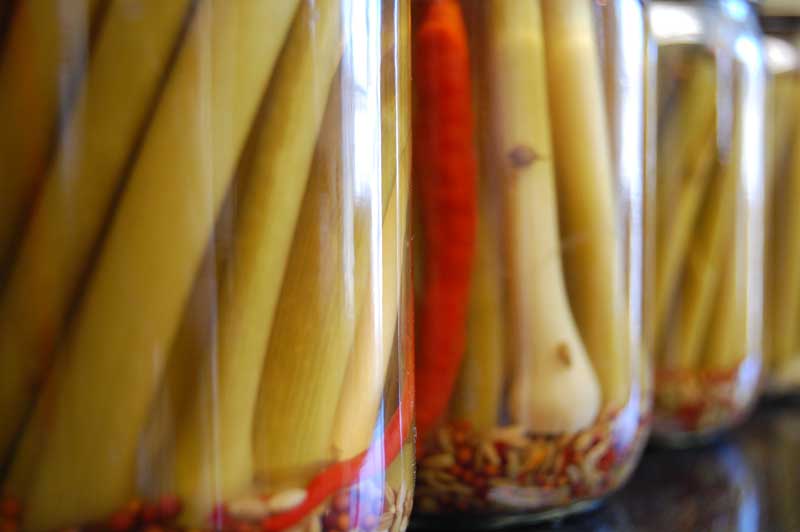
Green garlic pickles, an early experiment for the Gleaning Project.
For farmers all over the country, growing more than they can sell is just a part of doing business. As is routinely tilling surplus produce back into the soil. And because space is limited and time is of the essence, most farmers don’t have many other options — even if it usually means thousands of pounds of uneaten food.
“Nothing is lost when you turn something under; it just goes back into the dirt,” says Andy Griffin, owner of Watsonville, Calif.-based Mariquita Farm. “For us, loss comes when we’ve spent money to pick something, wash it, pack it, refrigerate it, and put it in a box, then [have to] take it out of the box and throw it away.” Of course, one could argue that the water and fertilizer required to grow the food — as well as the labor — is indeed lost, even if these are standard costs to farmers.
As much as Griffin says he’d like to see every vegetable he grows find a home, he has to be realistic. “Sometimes you need a bunch of stuff out of the way. Rather than wait and lose the opportunity to put the next crop in, I turn whatever’s out there under. There’s a choreography to moving stuff through the fields.”
Yet in this tightly timed dance, local food entrepreneur Larry Bain saw a chance to cut in. Owner of a Bay Area-based grass-fed beef hot dog company called Let’s Be Frank, Bain saw an enormous surplus of organic produce and an eager market looking to buy it, but a scarcity of good distribution options. What would happen, he wondered, if someone were to create minimally processed, shelf-stable products out of this extra produce?
This summer, Bain has teamed up with San Francisco’s Bi-Rite Market and several other Bay Area businesses to find out. He’ll buy the surplus produce at a reduced price from California farmers like Griffin, in an effort to “capture the food at its very best moment,” preserve it, and sell it under their new label, The Gleaning Project.
According to the Bi-Rite website, the grocery estimates that “every year [their] farmers plow under almost 50 percent of what they grow when market conditions make them unprofitable to harvest, pack and ship.”
This first summer, Bain says he’s taking a “chaotic approach” with the project. One of the Gleaning Project’s first experiments was green garlic, a crop that’s less perishable than most, making it the perfect starter crop. After buying 280 pounds of green garlic from Griffin at $2.75 per pound — 50 cents lower than Griffin’s target price but high enough for him to pay for labor and still make a profit — Bain sent the large bulk of it to the nearby commercial kitchen where it became 260 jars of green garlic pesto. A smaller portion went to local preservers, which turned it into 85 jars of green garlic pickles. Now, both products are being sold at Bi-Rite for $9.99 per jar. (It’s almost hard to believe that they’re made from the same vegetable: Though both retain that garlicky taste, the pickles are spicy and crunchy — perfect for a Bloody Mary — while the pesto is mild and smooth.) According to Bain, “each of the partners got pretty close to equal portions of the final sale price of the product.” No one will see big money this year, but had Bain not stepped in, that 280 pounds of green garlic would have become fertilizer in Griffin’s fields.
Next, they’ll turn apricots into jam and August’s booming tomato crop into sauce. At the end of the year, they’ll look back and see which products were most successful.
The project’s success hinges on a number of factors and players, highlighting the interconnectedness and unpredictability of a local food system. Griffin may have only a few days to contact Bi-Rite and alert them of a surplus, and within that time, Bain needs to find a commercial kitchen that can handle the pickling and/or preserving.
Because many commercial kitchens have multiple week-long waiting lists, the companies he’s working with play a crucial role by providing the space and skills for pickling on extremely short notice. For Jordan Champagne, co-owner of the preserving company Happy Girl Kitchen, that’s part of the fun. “It’s our flexible production model that really makes it possible. It tends to be kind of chaotic in its nature, but luckily I thrive on chaos, so it’s worked out perfectly.”


